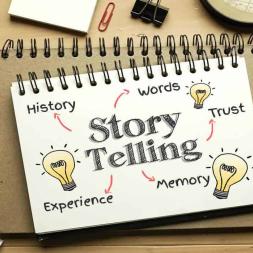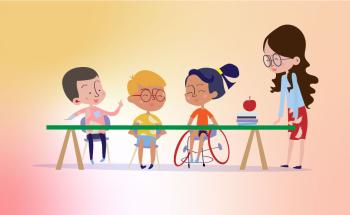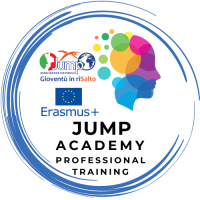
STORYTELLING/DIGITAL STORYTELLING As A Bridge Between Virtual And The Sensory
This training investigates the new era of digital learning and digital teaching at the preschool level to foster creativity and the creation of a permanent use of “Visual Storytelling”, which can be digital and physical. If well balanced can create a more creative pedagogy and support kids to learn while producing elements of the storytelling and developing communication skills.
Description
Quoting the Professor: “Storytelling is inseparable from humankind; therefore, many theorists also call the Homo Sapiens (the thinking man) Homo narrans (the story-telling man). Storytelling dates back to the very beginnings of human civilization, to the period considered the childhood of humankind. At the same time, telling fairy tales and stories is an integral part of every childhood. This is a portal through which the child enters the world of the literary world, but also the world of human experience, both the experience of civilization and the personal experience. In the act of oral narration, the boundary between the story, the storyteller, and the listener almost disappears, because the story is realized both in physical space-between the storyteller and the listener-and in virtual space, where the spoken word becomes a representation in the listener’s mind. The task of every storyteller is to tell a story in a way which would encourage the listener to let themselves go and enjoy the virtual world of the story. This process of immersion into the story will be significantly more successful if the storyteller uses techniques to evoke different sensations in the listener, thereby providing a deeper sense of immersive (co)operation. The paper will explain the importance of immersion in the encounter between the storyteller, the listener (pupil), and the story, and present several examples of how to stimulate children’s immersion and create richer representations by engaging various senses”.
The term virtual is today often associated with digital media, to refer to an imaginary space, separated from reality. Etymologically, the word virtual comes from the Latin word virtualis (medieval version) or virtus (excellence, potency, efficiency), and refers to that “which does not exist in reality; unreal, fictional, apparent” (“virtual”, 2020). The term virtual is primarily used in semiotics and semiology to explain the process of the emergence, and subsequent use of human communication through signs, including language”.
This training investigates the new era of digital learning and digital teaching at the preschool level to foster creativity and the creation of a permanent use of “Visual Storytelling”, which can be digital and physical. If well balanced can create a more creative pedagogy and support kids to learn while producing elements of the storytelling and developing communication skills.
Visual storytelling is extremely effective to learn a second language (English classes for example).
Visual storytelling involves the use of various visual props – these can be static images (illustrations, paintings, etc.) or dynamic props, such as dolls that we move. Given that other special disciplines explore the potential of puppets and theater, we will explain below the use of static images as visual cues in sensory-enriched storytelling.
In this training we also combine the value of visual and sensory. Senses are raised thanks to visual storytelling without words but with the development of a new kind of language, including body language and team work. Kids learn how to recognize and develop different senses. In different phases they learn how to communicate effectively and learn new languages.
The main goal of the training is to equip pre-school teachers with a kit of methods and tools, present online and created by JUMP for the participants, and become visual storytellers for their kids.
Learning objectives
- Understanding storytelling connected with teaching and its benefits
- Exploring a different way to cross storytelling with visual and digital teaching
- Fostering the use of creativity, critical thinking and cross-sectorial education in pre and primary schools
- Exploring different tools, methods and activities to be developed at school combining storytelling, visual and digital elements
- Sharing with other teachers the power of storytelling in pre-school and primary school education and experience together new types of international lesson plans
Methodology & assessment
Furthermore, in line with the JUMP Academy method, our courses are based on a strategic balance between formal and non-formal education, indoor and outdoor education and the team takes care of a very important aspect of international mobility which is the intercultural learning which we develop with short excursions and facilitating the interaction with local partners, businesses and citizens of our territory. Each local context has its own economy so it’s always useful, in training programs, to get in contact with concrete examples (experiential learning and real based learning).
We always try to connect our learners to local teachers and students to cooperate in developing innovation and networking for future projects.
Materials, digital tools & other learning resources
JUMP provides, after the completion of the course, all presentations, training materials and any other digital and learning tools used during the training sessions. Furthermore, extra materials are sent if there are updates and new ones researched afterwards.
Certification details
At the end of the training, JUMP delivers a formal certificate of attendance and the team is at disposal to fill the Europass certification document according to the EU model template and other needed documents for reporting of the sending institution.
Our courses are in line with the Erasmus+ Quality standards for courses under Key Action 1 (learning mobility of individuals)
Pricing, packages and other information
-
Course package content:
In the course fee are included: organization, administration, trainers' costs and classes, further training/learning materials, certification, support of the team H24, photo-video reporting.
Extra costs are referred to logistics. JUMP is sending all the precise info when the participants or the Erasmus coordinator ask for information.
-
Additional information:Description of the services and activities included in the course package (such as accommodation, meals, transport) or available at extra cost.
-
Cancellation & changes:
With a proper time in advance is possible to cancel the participation, informing and explaining the motivation.
-
Additional information:The options and conditions for change and cancellation, and the policy in case of unforeseen circumstances (force majeure).
Additional information
-
Language:English
-
Target audience ISCED:Primary education (ISCED 1)Lower secondary education (ISCED 2)Upper secondary education (ISCED 3)
-
Target audience type:TeacherHead Teacher / PrincipalLibrarian
-
Learning time:25 hours or more
Upcoming sessions
Past sessions
More courses by this organiser

TEACHING IN A GLOBAL CULTURAL CLASS ENVIRONMENT. The Culturally Responsive Teaching (CRT) Approach

SPECIAL NEEDS STUDENTS / SEN EDUCATION Practices And Policies In The European Context For Inclusion


